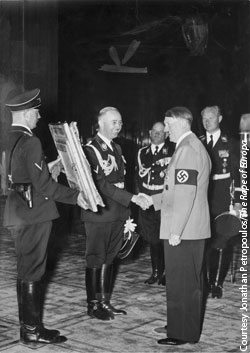 Jonathan Petropoulos, the John V. Croul Professor of European History and director of The Center for the Study of the Holocaust, Genocide, and Human Rights, is among a handful of experts appearing in a two-hour documentary, The Rape of Europa.
Jonathan Petropoulos, the John V. Croul Professor of European History and director of The Center for the Study of the Holocaust, Genocide, and Human Rights, is among a handful of experts appearing in a two-hour documentary, The Rape of Europa.
The film, which recently played at the Laemmle Claremont 5 and is still in nationwide release, is described by its makers as a story of the "systematic theft, deliberate destruction, and miraculous survival of Europe's art treasures during the Third Reich and the Second World War," juxtaposed with the story of artist Gustav Klimt's famed Gold Portrait, also known as the Golden Adelethe gold-flecked portrait of Adele Bloch-Bauer I. The painting was stolen from Viennese Jews in 1938 and is now, according to Europa's filmmakers, the most expensive painting ever sold.
Petropoulos says his involvement in The Rape of Europa dated from 1998, when he was serving as Research Director for Art and Cultural Property for a presidential commission that examined the assets of Holocaust victims in the United States.
Europa's filmmakers asked the CMC professor his advice about hot-button issues. "We got along well and I starting helping them as a consultant," Petropoulos says, "suggesting to them other people to interview, putting photographs in my archives at their disposal, and even traveling with them in Europe as they filmed."
Narrated by Joan Allen, The Rape of Europa brings viewers back to Adolf Hitler's Third Reich during World War IIthe height of his power in the early 1940s when he and his Nazi henchman pulled off perhaps the greatest heist in history. During that cataclysmic period in which millions died, high-ranking Nazi officials like Hermann Goering looted thousands of works of art from the homes of private citizens (many of them Jews who were forced to flee or who died in the Holocaust) and from national museums in the countries they conquered in Eastern Europe.
More than six decades after the fall of fascism in Germany, the effects of the state-sponsored program of Nazi theft continues, with thousands of art works still missing or sought by their original owners.
According to Petropoulos, perhaps hundreds of looted but never restituted Old Masters currently hang on the walls of North American and European museums.
"And there are thousands of less valuable works entering the art market, not to mention a great deal of so-called trophy art' still in Russian hands," he says. "Then there are the Swiss bank vaults. Because one can never have good title to stolen property according to U.S. law, heirs can continue to make claims in the years to come. In short, I expect to continue my work helping Holocaust victims and their families recover artworks for the rest of my career. And at the moment, I am busier than ever."
One of those whom Petropoulos assisteda Jewish woman born in Vienna who was forced to flee Austria after Hitler's Anchluss of the country in 1938is Maria Altmann, now a 91-year-old resident of Cheviot Hills. She and other family members laid claim to six paintings by Gustav Klimt, including the iconic picture of her aunt (Adele Bloch-Bauer I) valued at over $300 million. Petropoulos wrote an expert report for the plaintiffs, which was submitted to an Austrian arbitration panel. The panel ruled that five of the six paintings should be returned.
(Petropoulos' role in the recovery of the Golden Adele is recounted in the fall 2006 CMC magazine).
"The Altmanns' attorney, Randy Schoenberg, called me in 2001 and asked me to be an expert witness," Petropoulos recalls. "I confess that I never thought the case would go forward, that Maria Altmann and the family would be able to sue a sovereign country, Austria, in an American court. But after the Supreme Court ruling went their way, I spent about four months of a sabbatical I took at Cambridge University working on my report."
The paintings eventually were repatriated to Altmann, including the Adele Bloch-Bauer I portrait that she subsequently sold for $135 million to Ronald Lauder for his Neue Galerie in New York, making it at that time the most expensive painting ever sold.
Petropoulos currently is working on a new book that he characterizes as a kind of hybrid "part memoir, part archival-based monograph, part philosophical reflection." He added, "It concerns my 25 years tracking Nazi looted artworks, and more specifically, my experiences interviewing former Nazis. I would go to Bavaria and Austria most every summer and track down the hands-on plunderers."
The main subject of the book is Dr. Bruno Lohse, Hermann Goering's art agent in Paris during the war and the de-facto head of the main Nazi plundering agency in France (the ERR).
"Lohse was imprisoned by the Americans and French after the war for five years, but then resumed his career as an art dealer," Petropoulos says.
"He's a very problematic figure who trafficked in looted artworks and stashed some of them in Switzerland. I got to know him well, and this book is about my efforts to understand him and untangle his web of lies."
For more information about screenings of The Rape of Europa, visit the Laemmle Theaters Web site, which also includes information about the film: http://www.laemmle.com/viewmovie.php?mid=3098.
